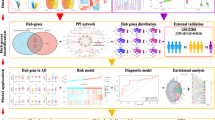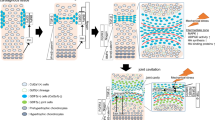Abstract
Osteoarthritis (OA) is one of the most prevalent skeletal diseases. Recently, we identified a novel gene on chromosome 3p24.3, named DVWA (double von Willebrand factor A domains), and its functional variants, which are associated with susceptibility to knee OA. Here we report the cloning and characterization of the DVWA gene. DVWA consisted of seven exons and had four alternative splicing variants, which encoded long (385 amino acid) and short (276 amino acid) proteins (L-DVWA and S-DVWA, respectively). S-DVWA was an N-terminal truncated form of L-DVWA and lacked a signal peptide and a part of a VWA domain. L-DVWA and S-DVWA transcripts were mainly expressed in articular cartilage. Immunoblot analysis using epitope-tagged proteins showed L-DVWA in the conditioned media and S-DVWA only in the cell, consistent with the in silico prediction. We also cloned the murine counterpart of DVWA, which was found to be identical to Col6a4, which has recently been reported. L-DVWA had 73% identity to the N-terminal sequence of the 2,309-amino acid Col6a4 protein. The mouse Dvwa/Col6a4 mRNA was present mainly in the small intestine in embryos and adults, but not in cartilage. The amino acid sequence of L-DVWA was conserved in higher species than chicken, but that of S-DVWA was unique in human. Knockdown of DVWA by siRNAs increased expression of chondrocyte matrix genes. Our study indicates that DVWA is evolutionally very unique, which, together with its specific expression in articular cartilage, suggests its specific role in human cartilage metabolism.






Similar content being viewed by others
References
Muir H (1995) The chondrocyte, architect of cartilage. Biomechanics, structure, function and molecular biology of cartilage matrix macromolecules. Bioessays 17:1039–1048
Kellgren JH, Lawrence JS, Bier F (1963) Genetic factors in generalized osteo-arthrosis. Ann Rheum Dis 22:237–255
Spector TD, Cicuttini F, Baker J, Loughlin J, Hart D (1996) Genetic influences on osteoarthritis in women: a twin study. BMJ 312:940–943
Kizawa H, Kou I, Iida A, Sudo A, Miyamoto Y, Fukuda A, Mabuchi A, Kotani A, Kawakami A, Yamamoto S, Uchida A, Nakamura K, Notoya K, Nakamura Y, Ikegawa S (2005) An aspartic acid repeat polymorphism in asporin inhibits chondrogenesis and increases susceptibility to osteoarthritis. Nat Genet 37:138–144
Miyamoto Y, Mabuchi A, Shi D, Kubo T, Takatori Y, Saito S, Fujioka M, Sudo A, Uchida A, Yamamoto S, Ozaki K, Takigawa M, Tanaka T, Nakamura Y, Jiang Q, Ikegawa S (2007) A functional polymorphism in the 5′ UTR of GDF5 is associated with susceptibility to osteoarthritis. Nat Genet 39:529–533
Miyamoto Y, Shi D, Nakajima M, Ozaki K, Sudo A, Kotani A, Uchida A, Tanaka T, Fukui N, Tsunoda T, Takahashi A, Nakamura Y, Jiang Q, Ikegawa S (2008) Common variants in DVWA on chromosome 3p24.3 are associated with susceptibility to knee osteoarthritis. Nat Genet 40:994–998
Whittaker CA, Hynes RO (2002) Distribution and evolution of von Willebrand/integrin A domains: widely dispersed domains with roles in cell adhesion and elsewhere. Mol Biol Cell 13:3369–3387
Nolte M, Pepinsky RB, Venyaminov S, Koteliansky V, Gotwals PJ, Karpusas M (1999) Crystal structure of the alpha1beta1 integrin I-domain: insights into integrin I-domain function. FEBS Lett 452:379–385
Chapman KL, Mortier GR, Chapman K, Loughlin J, Grant ME, Briggs MD (2001) Mutations in the region encoding the von Willebrand factor A domain of matrilin-3 are associated with multiple epiphyseal dysplasia. Nat Genet 28:393–396
Mabuchi A, Haga N, Maeda K, Nakashima E, Manabe N, Hiraoka H, Kitoh H, Kosaki R, Nishimura G, Ohashi H, Ikegawa S (2004) Novel and recurrent mutations clustered in the von Willebrand factor A domain of MATN3 in multiple epiphyseal dysplasia. Hum Mutat 24:439–440
Atsumi T, Miwa Y, Kimata K, Ikawa Y (1990) A chondrogenic cell line derived from a differentiating culture of AT805 teratocarcinoma cells. Cell Differ Dev 30:109–116
Takigawa M, Tajima K, Pan HO, Enomoto M, Kinoshita A, Suzuki F, Takano Y, Mori Y (1989) Establishment of a clonal human chondrosarcoma cell line with cartilage phenotypes. Cancer Res 49:3996–4002
Nakajima M, Kizawa H, Saitoh M, Kou I, Miyazono K, Ikegawa S (2007) Mechanisms for asporin function and regulation in articular cartilage. J Biol Chem 282:32185–32192
Hoshino M, Sone M, Fukata M, Kuroda S, Kaibuchi K, Nabeshima Y, Hama C (1999) Identification of the stef gene that encodes a novel guanine nucleotide exchange factor specific for Rac1. J Biol Chem 274:17837–17844
Letunic I, Copley RR, Pils B, Pinkert S, Schultz J, Bork P (2006) SMART 5: domains in the context of genomes and networks. Nucleic Acids Res 34:D257–D260
Nakai K, Horton P (1999) PSORT: a program for detecting sorting signals in proteins and predicting their subcellular localization. Trends Biochem Sci 24:34–36
Gara SK, Grumati P, Urciuolo A, Bonaldo P, Kobbe B, Koch M, Paulsson M, Wagener R (2008) Three novel collagen VI chains with high homology to the alpha3 chain. J Biol Chem 283:10658–10670
Fitzgerald J, Rich C, Zhou FH, Hansen U (2008) Three novel collagen VI chains, alpha4(VI), alpha5(VI), and alpha6(VI). J Biol Chem 283:20170–20180
Lee JO, Rieu P, Arnaout MA, Liddington R (1995) Crystal structure of the A domain from the alpha subunit of integrin CR3 (CD11b/CD18). Cell 80:631–638
Steiper ME, Young NM (2006) Primate molecular divergence dates. Mol Phylogenet Evol 41:384–394
Johnson JM, Castle J, Garrett-Engele P, Kan Z, Loerch PM, Armour CD, Santos R, Schadt EE, Stoughton R, Shoemaker DD (2003) Genome-wide survey of human alternative pre-mRNA splicing with exon junction microarrays. Science 302:2141–2144
Joun H, Lanske B, Karperien M, Qian F, Defize L, Abou-Samra A (1997) Tissue-specific transcription start sites and alternative splicing of the parathyroid hormone (PTH)/PTH-related peptide (PTHrP) receptor gene: a new PTH/PTHrP receptor splice variant that lacks the signal peptide. Endocrinology 138:1742–1749
Tabuchi M, Tanaka N, Nishida-Kitayama J, Ohno H, Kishi F (2002) Alternative splicing regulates the subcellular localization of divalent metal transporter 1 isoforms. Mol Biol Cell 13:4371–4387
Loftus JC, Liddington RC (1997) Cell adhesion in vascular biology. New insights into integrin-ligand interaction. J Clin Invest 99:2302–2306
Bienkowska J, Cruz M, Atiemo A, Handin R, Liddington R (1997) The von Willebrand factor A3 domain does not contain a metal ion-dependent adhesion site motif. J Biol Chem 272:25162–25167
Canti C, Nieto-Rostro M, Foucault I, Heblich F, Wratten J, Richards MW, Hendrich J, Douglas L, Page KM, Davies A, Dolphin AC (2005) The metal-ion-dependent adhesion site in the von Willebrand factor-A domain of alpha2delta subunits is key to trafficking voltage-gated Ca2+ channels. Proc Natl Acad Sci USA 102:11230–11235
Acknowledgments
We thank Ms. Yoshie Takanashi and Tomoko Kusadokoro for excellent technical assistance.
Author information
Authors and Affiliations
Corresponding author
About this article
Cite this article
Nakajima, M., Miyamoto, Y. & Ikegawa, S. Cloning and characterization of the osteoarthritis-associated gene DVWA . J Bone Miner Metab 29, 300–308 (2011). https://doi.org/10.1007/s00774-010-0230-z
Received:
Accepted:
Published:
Issue Date:
DOI: https://doi.org/10.1007/s00774-010-0230-z




